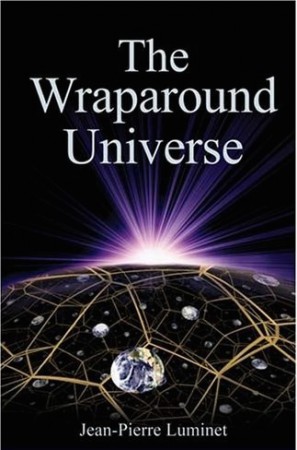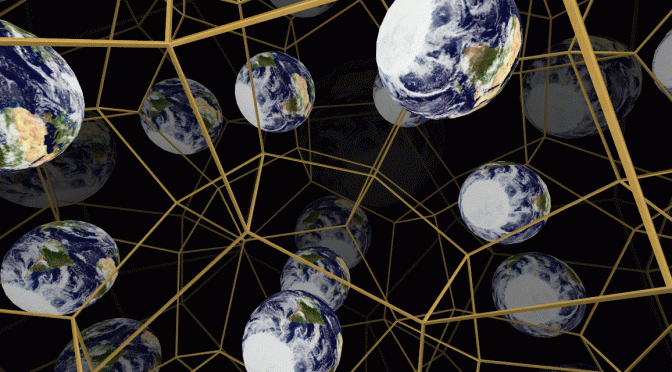Until now I published as an author 30 books in my native language (French), including 14 science essays, 7 historical novels and 9 poetry collections (for the interested reader, visit my French blog here.
Although my various books have been translated in 14 languages (including Chinese, Korean, Bengali…), only 4 of my essays have been translated in English.
The fourth one was :
The Wraparound Universe
316 pages – AK Peters Ltd, 2008 – ISBN 978 1 56881 309 7 – ISBN 0 521 40906 3 (paperback)
 What shape is the universe? Is it curved and closed in on itself? Is it expanding? Where is it headed? Could space be wrapped around itself in a formation that produces ghost images of faraway galaxies? Such are the questions posed by Jean-Pierre Luminet, which he then addresses in clear and accessible language. An expert in black holes and the big bang, he leads us on a voyage through the surprising byways of space-time, where possible topologies of the universe, explorations of the infinite, and cosmic mirages combine their mysterious traits and unlock the imagination.
What shape is the universe? Is it curved and closed in on itself? Is it expanding? Where is it headed? Could space be wrapped around itself in a formation that produces ghost images of faraway galaxies? Such are the questions posed by Jean-Pierre Luminet, which he then addresses in clear and accessible language. An expert in black holes and the big bang, he leads us on a voyage through the surprising byways of space-time, where possible topologies of the universe, explorations of the infinite, and cosmic mirages combine their mysterious traits and unlock the imagination.
Praise for The Wraparound Universe
– “Luminet’s deep understanding of the history of cosmology combines with his scientific knowledge and expository skills to produce a delightful introduction to the much-debated question of the shape of the universe. Directed at an intelligent layperson, The Wraparound Universe combines geometrical insights with astronomical observations leading to the idea of a universe that is finite yet has no boundary.” (Jeff Weeks, author of The Shape of Space)
– “This book is well written and nicely illustrated, giving a clear exposition of the mathematical and astronomical ideas involved as well as the various ways of observationally testing this possibility.” (George Ellis, Cape Town University, Templeton Prize)
Available on amazon : click here
************************************************************************
PRESS REVIEWS
New Scientist, CERN Courier, etc : Click here
************************************************************************
EXCERPT (CHAPTER 1)
1 . The Universal Mollusk
What is the shape of space? This is one of the questions that has most intrigued me for the last 30 years, since a summer afternoon that has remained etched in my memory. I was a teenager, reading a popular encyclopedia of astronomy in my sun-drenched garden. At the end of the book, some more technical pages introduced the ideas of general relativity and curved space. I understood nothing, but I was fascinated. A certain Albert Einstein had shown that space and time were not as simple as was suggested by our geometric intuition. One statement above all piqued my curiosity: it said that, in a gravitational field, the space-time continuum was no longer Euclidean, but became a referential mollusk. A very clear image formed right away in my mind. To the flavor of the words was added
their metaphorical value: in my imagination the space-time mollusk gave birth to a picturesque vision of an immense cosmic snail, its skin streaked through with light, variegated in bends and curves. From then on, I have never stopped seeking to clarify this strange assertion—what is this universal mollusk?—and I have never
again looked the same way upon the beautiful starry skies of my native Provence.
It was no longer the myriad of stars, flowing through the Milky Way like rivers of diamonds, that intrigued me, but that which surrounded them, space. It was no longer the contents but the container that caused questions to rush forward: does this impalpable space, which contains the stars, have a structure? Is it flat, dented, curved, folded, smooth, rough, grainy? Is it finite or infinite? Does it have boundaries, holes, handles? And then, what does it mean, exactly, to say that space has a shape?
It was at this time that I decided to interest myself not so much in the Universe as it is, but in the Universe as it may be, while remaining within the limits of reasonable physics (without which, all fantasies would be permitted and my hypotheses would no longer correspond to scientific work). It took me many years before I began to put rational content into this poetically resonant mollusk.
As understood by common sense, it is normal to think of space as some kind of empty, shapeless receptacle, which welcomes material bodies. Some philosophers have tried to flesh out this receptacle by picturing it more like a material, an ethereal substance that would simultaneously contain and interpenetrate physical objects. For a scientist, questions about space are not pertinent unless some mathematics gives them meaning. It is in fact only today that mathematics, properly applied, can pose proper questions about space and, if need be, help us to resolve them. Although it may not teach us that space necessarily exists as an objective reality (a question that still lies in the realm of philosophy), mathematics at least gives space an existence as a structure, defined by its symmetries and by its shapes.
The study of shapes is a science in itself, which is connected to geometry. Geometers have the habit of juggling with spaces that defy common sense. These include spaces that possess 11 or 80 dimensions; spaces that are completely smooth or, on the contrary, discontinuous; spaces riddled with holes; and spaces that have boundaries or that end brutally at angular points. However, these abstract spaces have almost no relation to physical space. Then again, if you think about it, even the most elementary geometrical objects, although used in everyday language, are abstractions: a point being an element without extent, a line a collection of points,
a plane being formed by lines, and a solid volume being an aggregate of planes— none of this exists in the real Universe. However, this real Universe, which contains material objects, living creatures, stars, galaxies, waves, and radiation—what can be said of it by the physicist, the mathematician, or the astronomer? Was there a beginning? Is it eternal or ephemeral? Is space finite or infinite?
When I first began to wonder about nature, about the grandeur and origin of the Universe, I did not know that these were some of the questions that humankind has asked itself since long ago. In nearly every culture, philosophers, scholars, or artists have supplied various explanations, which have evolved over the course of history. If modern cosmology and the big-bang solutions that flow from it see such public success at present, it is because they try to respond to these questions by combining mathematical reasoning, physical models, and astronomical observations.
After a century of remarkable advances, cosmologists are on the verge of resolving some of these enigmas. I shall do my best in particular to show how, with a little geometry and telescopes of greater perfection, we hope over the next few years to succeed in measuring the size and shape of space.
Up until now, I have sometimes used the word Universe in place of the word space. This identification is common in everyday usage. Nevertheless, it is incorrect. It is therefore useful to outline the distinctions between mathematical space, physical space, space-time, and the Universe:
• A mathematical space is a collection of objects upon which a structure is defined (e.g., a collection of points, between which one defines distances). There are as many mathematical spaces as there are possible structures, that is, an infinite number, which will never be exhausted by the human imagination. Until the nineteenth century, the only known mathematical space was Euclidean space, whose geometric structure derived from the postulates given by Euclid in antiquity, and whose elementary rules we all have learned in school.
• Physical space, on the contrary, is unique. If one believes the definition in the dictionary, it is the limitless expanse that contains material objects. In everyday language, it is the space of conquest, through which the Starship Enterprise sails in Star Trek. But that this space possesses a certain number of dimensions, three, as it happens, that it is finite or infinite, that it is flat or curved, etc., is far from evident! The reason for this is that our perceptive space is a priori distinct from physical space (note : The semicircular canals of our internal ear, which detect the rotational acceleration of the head in three perpendicular planes, help to construct a mental space of locally Euclidean structure; see for example [Berthoz 02]). The physicist tries to precisely describe the indefinite expanse that is space by means of a geometric model. As we shall see, there are many possible models; the description obtained depends notably on the degree of precision with which the physical space is analyzed.
• Space-time is a theoretical entity that unites a three-dimensional geometrical space with a one-dimensional temporal continuum. It is, therefore, a four-dimensional space supplied with a number of possible (generally non-Euclidean) structures, which serves as a framework for the theories of relativity.
• The Universe, by definition, is the ensemble of everything that exists. In general relativity, it is modelled by a complex combination that unites the container with the contents, that is to say, space and time, but also energy in all its forms (matter, light, vacuum energy). The relativistic Universe is physical space, woven through time and carved by matter. Because of this, certain cosmological assertions that identify the Universe with its spatial component only—for example, the assertion that the Universe is flat—can cause some confusion for the reader.
• Finally, there is the notion of the observable Universe, that I shall from now on call universe with a lower case u. In contrast to the Universe, space-time and matter in their entirety, which seemingly has neither center nor frontier, neither interior nor exterior, the observable universe is centered on the terrestrial observer and has a border. Every astronomical investigation actually plunges us into the past, since the information comes to us through the intermediaries of radiation (electromagnetic or gravitational) or of particles (neutrinos, cosmic rays), travelling at a finite speed. However, this return to the past necessarily reaches a limit, corresponding to an epoch when no radiation source had yet formed. The observable universe is therefore only a portion of space-time, circumscribed by a cosmological horizon: it is the interior of a sphere centered on us, whose present-day radius is approximately 50 billion light years. Over the course of cosmic expansion, the radius of this spherical horizon grows as a function of time, at a speed that depends on the chosen cosmological model.
Let us keep these different meanings in mind. It is probable that, in the rest of this book, I will now and again use the word universe in place of the word space, simply for ease of discourse, and only in those places where there is no risk of error in the interpretation that follows.

nice post
beau partage
I read with interest your 2005 Physics World column “ A cosmic hall of mirrors” (https://physicsworld.com/a/a-cosmic-hall-of-mirrors/). In light of the Planck data, I would be interested to see an updated version on your blog.